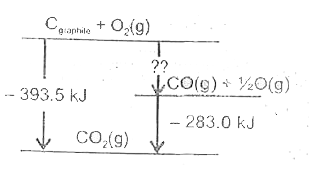Complete Solutions to ASSIGNMENT (Section - B) Objective Type Questions of chapter THERMODYNAMICS of Class 12 book with complete answers and questions
| Class 12 | CHEMISTRY |
| Chapter | THERMODYNAMICS |
| AAKASH INSTITUTE | ASSIGNMENT (Section - B) Objective Type Questions |
| Number Of Questions | 35 |
| Academic Year | 2023-24 |
Let `(C_v) and (C_p)` denote the molar heat capacities of an ideal gas at constant volume and constant pressure respectively . Which of the following is a universal constant?
View SolutionWhen an ideal gas is compressed adiabatically and reversibly, the final temperature is:
View Solution`Delta S^(@)` will be highest for the reaction
View SolutionIn a reversible process, the value of `Delta S _(sys) + Delta S_(surr) is`
View SolutionA closed flask contains a substance in all its three states, solids, liquids and vapour at its triple point. In this situation the average KE of the water molecule will be
View SolutionA process is called reversible when
View SolutionThe molar heat capacity C of water at constant pressure is `75 JK^(-1) "mol"^(-1)` , when 1.0 KJ of heat is supplied to 100 g of water which is free to expand, the increase in temperature of water is
View Solution`16kg` oxygen gas expands at `STP` to occupy double of its oxygen volume. The work done during the process is:
View SolutionWhen enthalpy and entropy change for a chemical reaction are `-2.5 xx10^(3)` cals and `7.4` cals `K^(-1)` respectively. Predict that reaction at 298 K is
View SolutionThe temperature at which the given reaction is at equilibrium `Ag_(2)O_(s) rightarrow 2Ag(s) + 1/2 O_(2)(g)`
`Delta H = 40.5 kJ mol^(-1)` and `DeltaS= 0.086 k J mol^(-1) K^(-1)`
View SolutionOne mole of a non-ideal gas undergoes a change of state `(2.0 atm, 3.0 L, 95 K) rarr (4.0 atm, 5.0L, 245 K)` with a change in internal energy, `DeltaE = 30.0 L-atm`. The change in enthalpy `(DeltaH)` of the process in `L-atm` is
View SolutionWhich of the following can be zero for isothermal reversible expansion?
View SolutionIn an isulated container water is stirred with a rod to increase the temperature. Which of the following is true?
View SolutionTwo atoms of hydrogen combine to form a molecule of hydrogen gas, the energy of the `H_(2)` molecule is :
View SolutionThe temperature of 15 ml of a strong acid increases by `2^(@)C` when 15 ml of a strong base is added to it. If 5 ml of each are mixed, temperature should increase by
View SolutionThe standard heat of formation of `NO_(2)(g)` and `N_(2)O_(4)(g) ` are `8.0` and `4.0 kcal mol ^(-1)` respectively. The heat of dimerisation of `NO_(2)` in kcal is`
View SolutionIf `(1)/(2)X_(2)O_((s)) rarr X_((s))+(1)/(4)O_(2(g)),DeltaH=90kJ` then heat change during reaction of metal `X` with `1 mol e O_(2)` to form oxide to maximum extent is `:`
View SolutionFor a gaseous reaction
`A(g) + 3 B(g) rightarrow 3C(g) + 3D(g)`
`Delta E` is 27 kcal at `37^(@)C`. Assuming `R = 2 cal K^(-1) mol^(-1)` the value of `Delta H` for the above reaction will be
View SolutionA mixture of `2` moles of `CO` and `1` mole of `O_(2)`, in a closed vessele is ignited to convert the `CO` to `CO_(2)` if `Delta H` is the enthalpy change and `Delta U` is the change in internal energy then:
View SolutionThe bond dissociation energies of `X_2, Y_2 and XY` are in the ratio of `1 : 0.5 : 1. DeltaH` for the formation of XY is -200 kJ mol^(-1)`. The bond dissociation energy of `X_2` will be
View SolutionVapour density of a gas is 8. Its molecular mass will be
View SolutionIf x mole of ideal gas at `27^(@)C` expands isothermally and reversibly from a volume of y to 10 y, then the work done is
View SolutionEnthalpy of formation of `NH_(3)` is -X kJ and `Delta H_(H-H)`, `Delta H_(N-H)` are respectively Y kJ`mol^(-1)` and Z kj`mol^(-1)`. The value of `Delta H_(N = N) is`
View SolutionA system X undergoes following changes
`underset(P_(1)V_(1)T_(1))(X)to underset(P_(2)V_(2)T_(1))(W)tounderset(P_(3)V_(2)T_(2))(Z)tounderset(P_1V_(1)T_(1))X`
The overall process may be called as
View SolutionThe heat of neutralisation for strong acid and strong base forming 2 moles of water is
View SolutionThe value of `Delta H^(@)` in kJ for the reaction will be `CS_(2)(l) + 4NOCl(g) rightarrow CCCl_(4)(l) + 2SO_(2)(g) + 2N_(2)(g)` if
`Delta H_(t)^(@)(CS_(2)) = -X`
`DeltaH_(l)^(@)(NOCl) = -y`
`Delta H_(l)^(@)(CCCL_(4)) = + z`
`Delta H_(l)^(@)(SO_(2)) = - r`
View SolutionThe heat librerated on complete combustion of 1 mole of `CH_(4)` gas to `CO_(2)(g)` and `H_(2)O(l)` is 890 kJ. Calculate the heat evolved by `2.4 L of CH_(4)` on complete combustion.
( 1 mol of CH4 at 298K and 1 atm= 24L)
View SolutionThe work done in an open vessel at `300K`, when `112g` iron reacts with dil. `HCL` is:
View SolutionWhich statement is correct?
View SolutionA schematic representation of enthalpy changes for the reaction,` C_("graphite") + 1/2 O_(2)(g) rightarrow CO(g)` is given below. The missing value is

View SolutionWhich of the following equations respresents standard heat of formation of `CH_(4)` ?
View SolutionDifferent types of systems are given below

The A and B systems respectively are
View SolutionSet of intensive properties is shown by
View SolutionFor the expansion occuring from initial to final stage in finite time, which is incorrect?
View SolutionCalorific value of ethane, in k J/g if for the reaction `2C_(2)H_(6) + 7O_(2) rightarrow 4CO_(2) + 6 H_(2)O, Delta H = -745.6 kcal`
View Solution
ASSIGNMENT (Section - B) Objective Type Questions questions and complete solutions for chapter THERMODYNAMICS of AAKASH INSTITUTE ENGLISH of Class 12
All Exercises from AAKASH INSTITUTE Class 12 CHEMISTRY THERMODYNAMICS
- ASSIGNMENT (Section - A) Objective Type Questions
- ASSIGNMENT (Section - B) Objective Type Questions
- ASSIGNMENT (Section - C) Previous Years Questions
- ASSIGNMENT (Section -D) Assertion-Reason Type Questions
- EXAMPLE
- Exercise
- SECTION-A
- SECTION-B
- SECTION-C
- SECTION-D
- SECTION-E
- SECTION-F
- SECTION-G
- SECTION-H
- SECTION-I
- SECTION-J
- TRY YOURSELF